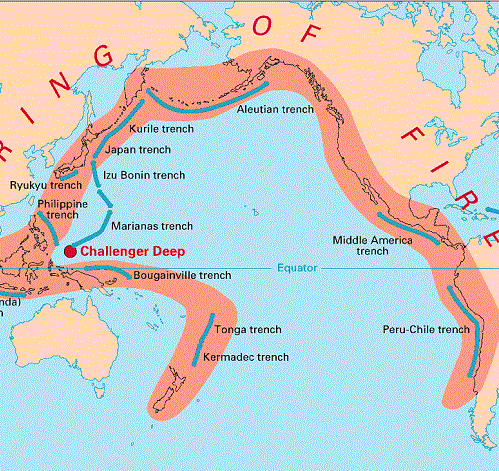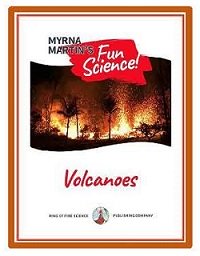Pacific Ring of Fire Volcanoes & Earthquakes
Ring of Fire
Exploding volcanoes
The Pacific Ring of Fire has more exploding volcanoes and great earthquakes than any other place on Earth. This 40,233 km (25,000 mile) ribbon of land and water is home to 75% of the world's active and dormant volcanoes.
80% Great Earthquakes
Earthquakes are common in the the Ring of Fire where 90% of earthquakes worldwide occur and 80% of the great earthquakes on our planet occur.

Ring of Fire around the Pacific Ocean, USGS
Pacific Northwest Cascadia Subduction zone
Convergent boundaries around Pacific Ocean
The Ring of Fire volcanoes that surround the Pacific Ocean formed at convergent boundaries. The Cascadia Subduction Zone in the Pacific Northwest has experience large earthquakes in the past and scientists believe another could occur in the future.
Living on the Ring of Fire in a subduction zone
Living on the Cascadia Subduction Zone my family realizes there is about a 50% chance of our home being struck by a 9+ earthquake. Driving to town towering volcanoes are easily visible. These volcanoes have formed on the Ring of Fire in a subduction zone.
the Pacific Plate is shrinking
Shrinking Pacific Plate
Tectonic plate movement occurs as the Pacific Plate is recycled in subduction zones. The Pacific Plate is older and heavier than the surrounding plates. At convergent boundaries subduction zones form towering stratovolcanoes on the landward side of the subduction zones. The subducting ocean plates are recycled in the upper mantle as they melt.

Volcanoes are mountains of fire that are fascinating to watch erupt. Find out how and why these volcanoes erupt around the Pacific Ring of Fire. The chapters in our Volcanoes book is filled with information on volcanoes and an activity in every chapter. Myrna

Click for More Information and to Order
Alaska's Aleutian Islands
Aleutian Islands are an island arc of volcanoes
The Aleutian Islands are an island arc of volcanic islands that have formed as the Pacific Plate subducts beneath the North American Plate in the north Pacific Ocean. The Aleutian trench separates the Pacific Plate from the North American Plate in this area.
Subduction zone in the North Pacific
The island arc of volcanoes continues and forms a volcanic arc on the mainland area of Alaska. Famous and dangerous volcanoes include Mt. Spurr and Redoubt Volcano in this part of Alaska.
San andreas Fault
Pacific Plate and North American Plate boundary
The San Andreas Fault is a famous fault that runs almost down the length of California in the United States. The fault separates the North American Plate and the Pacific Plate. People living west of the San Andreas Fault live on the Pacific Plate. People living on the east side of the fault live on the North American Plate.
Right lateral transform boundary
The San Andreas Fault is a right-slip transform fault. It is called a right slip transform fault because the two plates are slipping horizontal past each other. Looking across the fault to land on the other side it looks like the land has moved to the right of where you would be standing.
KIDS FUN Science Bookstore
Check out Myrna Martin's award winning textbooks, e-books, videos and rock sets. The Kids Fun Science Bookstore covers a wide range of earth science topics. Click here to browse.










